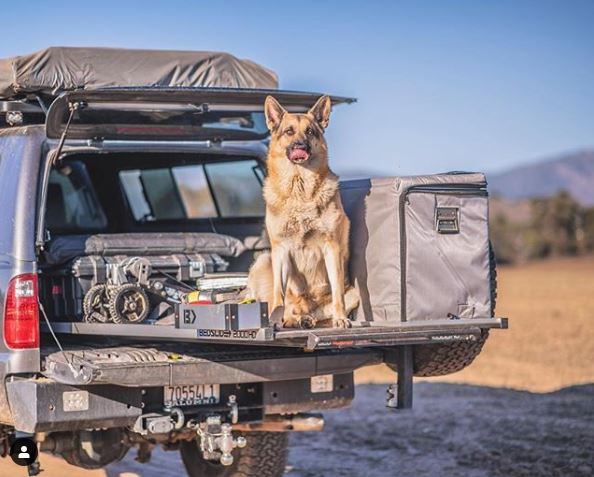Introduction
Overlanding is a thrilling way to explore the world on your own terms, combining adventure, self-reliance, and the freedom of the open road. For dog owners, the journey becomes even more rewarding when shared with a loyal canine companion. Traveling with your dog not only strengthens the bond between pet and owner but also adds a unique dimension to your adventure. However, overlanding with dogs comes with its own set of challenges, including safety, gear requirements, and route planning.
This guide is designed for beginners and experienced overlanders alike, providing actionable overlanding dog tips, insights on essential pet gear overland, and strategies to ensure a safe, comfortable, and memorable journey for both you and your dog. Whether you’re planning a weekend getaway or a multi-week overland expedition, preparation is key.
Preparing for the Journey
Before hitting the road, preparation is essential to ensure your dog’s safety, comfort, and well-being throughout the trip.
Health and Safety Precautions
- Vet Check-Ups: Schedule a comprehensive veterinary check-up. Ensure vaccinations are up-to-date and your dog is in good health for travel.
- Identification: Make sure your dog is microchipped and wearing a collar with updated contact information.
- Emergency Information: Carry a list of local veterinarians, emergency clinics, and pet insurance details for each destination.
Training and Behavior
- Vehicle Acclimation: Introduce your dog gradually to car rides to reduce stress. Start with short trips and progressively increase duration.
- Camping Adaptation: Familiarize your dog with tents, sleeping arrangements, and outdoor noises before the trip.
- Basic Obedience: Commands like sit, stay, and come are essential for safety during hikes, campsite setups, or encounters with wildlife.
Legal Considerations
- Travel Documentation: Check regulations for domestic and international travel, including health certificates and permits.
- Pet Policies: Understand local rules for dogs on trails, national parks, and campsites to avoid fines or restrictions.
- Crossing Borders: Ensure all vaccination records and documentation comply with border requirements, especially in Europe or other continents with strict regulations.
Essential Gear for Overlanding with Dogs
The right gear ensures comfort, safety, and convenience while traveling with your dog.
Travel Essentials
| Gear Item | Purpose |
|---|---|
| Leashes & Harnesses | Safe control during stops and outdoor activities |
| Portable Water Bowls | Keeps your dog hydrated on the go |
| Food Containers & Snacks | Ensures proper nutrition without spoilage |
| Dog Seat Covers & Crates | Provides safety and comfort inside the vehicle |
Tips:
- Invest in durable, washable gear to withstand dirt and outdoor conditions.
- Pack multiple leashes or harnesses for different activities (e.g., hiking vs. campsite).
- Use seatbelts or secured crates to prevent injury during off-road travel.
Camping Gear for Dogs
| Gear Item | Purpose |
|---|---|
| Dog-Friendly Tents | Keeps your dog sheltered and protected |
| Sleeping Pads & Blankets | Adds comfort and insulation for restful sleep |
| Cooling Mats & Jackets | Helps regulate body temperature in extreme climates |
| Portable Kennels | Offers a secure area for your dog while unattended |
Tips:
- Place dog bedding slightly elevated off the ground to avoid moisture.
- Ensure tents are well-ventilated and provide shade during hot days.
- Familiarize your dog with new gear before departure to reduce stress.
Internal Link: For general camping gear, see our Overlanding Camping Gear: Tents, Sleeping Bags & Cooking Essentials guide.
Health and Safety Equipment
- First Aid Kit: Include dog-specific items like bandages, antiseptics, and tweezers for ticks or splinters.
- Flea and Tick Prevention: Apply preventative treatments regularly and check after hikes.
- Insect Repellents: Use pet-safe repellents to protect against mosquitoes and other pests.
Keyword Integration: safe overland with dogs, camping with pets overland
Pet-Friendly Overland Routes
Choosing routes that accommodate dogs ensures both adventure and safety.
Selecting Dog-Friendly Destinations
- Research Campsites: Look for campsites with pet-friendly policies, fenced areas, and nearby water sources.
- Trail Conditions: Avoid steep or overly rugged trails unsuitable for your dog’s size, age, or fitness.
- Wildlife Awareness: Be aware of local wildlife hazards such as snakes, large mammals, or aggressive birds.
Recommended Overland Routes for Dogs
- National Parks & Forests: Many U.S. and European parks allow leashed dogs on designated trails.
- Scenic Byways: Roads with frequent stopping points and safe walking areas.
- Coastal Routes: Gentle beaches and coastal trails suitable for dogs.
Tips for Remote Areas:
- Carry enough food and water for extended periods.
- Identify local veterinarians along the route.
- Maintain routine checks for signs of fatigue or heat stress.
Keyword Integration: dog friendly overland trips, traveling with dogs overlanding
On the Road: Tips for Traveling with Dogs
Vehicle Safety
- Secure Your Dog: Use crates, harnesses, or barriers to prevent movement during off-road travel.
- Temperature Control: Never leave your dog unattended in hot or cold vehicles.
- Ventilation: Ensure airflow without exposing dogs to strong winds or debris.
Daily Routines
- Exercise: Provide breaks every 2–3 hours for stretching and bathroom needs.
- Feeding: Maintain consistent feeding schedules to prevent digestive upset.
- Health Monitoring: Check paws, coat, and overall behavior daily for signs of stress or injury.
Campsite Management
- Safe Space: Designate an area for your dog away from campfire or heavy foot traffic.
- Waste Management: Always clean up after your pet to maintain hygiene and respect for the environment.
- Interaction: Supervise your dog around other campers and pets to avoid conflicts.
Keyword Integration: overland travel basics
Troubleshooting Common Issues
Separation Anxiety
- Bring familiar toys or blankets.
- Gradually increase time away from the dog during test trips.
- Reward calm behavior to reinforce security.
Health Emergencies
- Heatstroke: Symptoms include excessive panting, drooling, or lethargy. Move to shade and provide water.
- Dehydration: Ensure access to water at all times.
- Fatigue: Adjust travel pace or provide rest days for recovery.
Behavioral Challenges
- Excessive barking: provide stimulation with toys and mental exercises.
- Aggression or fear: use gradual exposure and positive reinforcement.
- Digging: designate safe areas for play to reduce destructive behavior.
Frequently Asked Questions (FAQs)
1. Can I take my dog on all overland routes?
Not all routes allow dogs. Always check trail regulations, campsite policies, and local laws.
2. What breeds are best suited for overlanding?
Active breeds that tolerate travel, heat, or long walks tend to do well. Small or elderly dogs may require extra care.
3. How do I find pet-friendly campsites?
Use online databases, forums, or official national park websites. Reading reviews from other travelers with dogs is invaluable.
4. What should I do if my dog gets lost?
Ensure microchipping, use GPS trackers, and notify local authorities. Always carry a recent photo for identification.
5. How can I keep my dog cool during hot weather?
Use cooling mats, shade, frequent water breaks, and avoid peak heat hours.
Conclusion
Traveling with your dog adds an extra layer of joy and companionship to overlanding. With careful preparation, the right pet gear overland, and attention to safety, both you and your dog can enjoy a memorable, safe, and adventurous journey. By following this guide’s overlanding dog tips, you’ll be ready to embark on your first pet-friendly overland adventure, exploring scenic trails, camping under the stars, and creating unforgettable memories with your four-legged companion.
Call-to-Action: Begin planning your next overland adventure with your dog today! Explore detailed gear guides, pet-friendly routes, and expert tips at Just Overland to ensure every journey is safe, enjoyable, and unforgettable.







